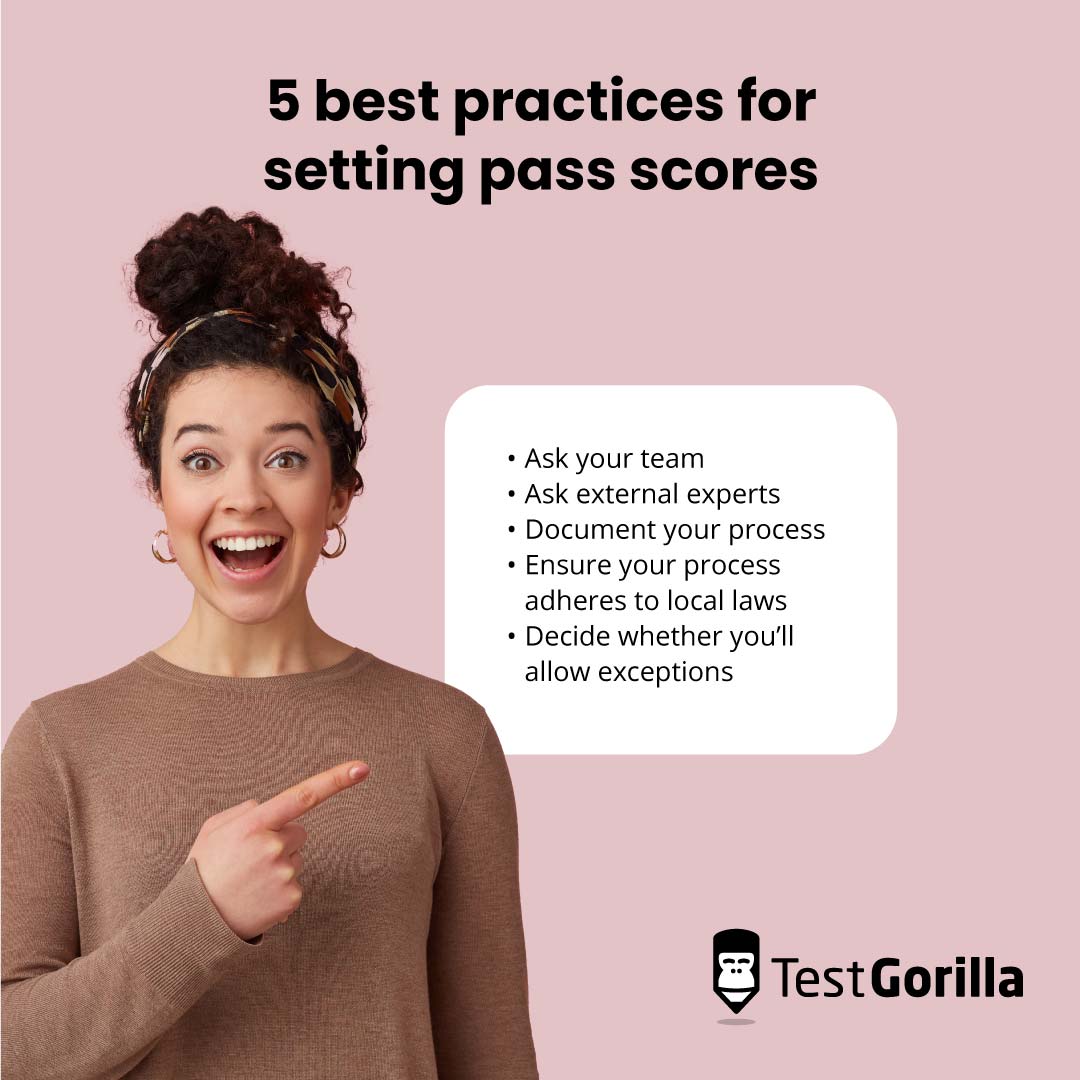A pass score determines whether or not a candidate moves to the next stage of hiring, so skills test results are pretty important.
Maybe you’re hiring for a developer role, so you need to assess their Flutter skills. Where should you set the bar to ensure they have the right skills? Is 80% too high? Is 50% too low?
The short answer is that pass scores should be set as high or low as needed to meet organizational requirements. Yes, unfortunately, it’s one of those “it depends” subjects.
However, there are plenty of considerations to keep in mind that can help you set the ideal cutoff score for skills tests, so you can narrow down your choices to the best but not omit excellent candidates.
In this article, we’ll discuss the importance of setting the right pass scores for pre-employment testing, as well as which roles should have higher or lower pass scores.
We’ll also discuss our top six best practices for determining pass scores for your skills assessments.
Table of contents
- What’s a cutoff score?
- Why setting the right pass scores is important
- Are pass scores the same for all test types?
- Are pass scores different depending on the type of role?
- What should you compare test results to?
- The 5 best practices for setting pass scores
- Determine a fair pass score and use skills tests to hire the best
- Source
What’s a cutoff score?
A cutoff score is a benchmark used in pre-employment assessments to filter out unsuitable candidates from your applicant pool, ensuring only the most qualified candidates move forward in the hiring process.
The cutoff score is the lowest attainable score to pass an assessment.
Cutoff scores must be:
Made by someone qualified to make them
Meaningful to the person who makes them
Made in a way that takes into account the purpose of the test
Following these three points ensures your cutoff score is fair and relevant to the role. It also guarantees the score filters out the right candidates so you’re left with only the best.
Setting the cutoff score for skills tests is crucial for many reasons:
Filters out applicants who don’t have the required skill set for the role
Reduces strain on hiring managers and the risk of mis-hiring
Ensures candidates have the skills they claimed to have in interviews or resumes
Lowers selection risk*
*Let’s quickly expand on this last point.
Selection risk is an issue most commonly seen in traditional hiring. This is related to false positives (low-quality candidates who look good on paper) and false negatives (high-quality candidates who look bad on paper).
Cutoff scores help reduce selection risk and ensure you hire the best possible candidate for the role, regardless of their pedigree or charisma. For more on this topic, read our article on skills-based hiring, impostor syndrome, and the Dunning-Kruger effect.
Why setting the right pass scores is important
Setting cutoff scores for your pre-employment assessments is the first step, but just having them isn’t enough. They have to be set at the right level.
What happens if they aren’t?
Pass scores that are too high can filter out stellar candidates who would have flourished at your organization, and pass scores that are too low could increase the risk of mis-hires.
Here’s an in-depth analysis.
If pass scores are too high
If your pass scores are too high, you’ll limit your talent pool for no reason and struggle to find the right talent.
This means excellent candidates could be filing into your organization, only to be sent on their way. Imagine having the ideal candidate, but they’re sent to a competitor because your score was set too high.
Too many authorities on test scores believe the only way to go is setting high cutoff scores.
They believe that if you set the pass score high, you’ll get perfect purple squirrels — and why waste time on anything less?
We challenge this idea. The world isn’t black and white. Candidates are faceted, and there are many factors that can affect test scores, including candidate anxiety.
And even if the candidate scored lower because they lack certain skills, you can train them if they match other important qualifications, like culture and personality.
This is also an excellent plan to attract more top talent. A recent study showed that 48% of workers would switch jobs if offered upskilling opportunities.
It’s also important to mention that skills are constantly shifting in our current landscape. Finding a “perfect fit” is close to impossible when the goalposts keep moving.
In many industries, it’s still a candidate market, and even if there is a “perfect candidate” out there, reaching them could be far out of your recruiting budget. The question is, do you want to get into a bidding war with a competitor or discover hidden talent for far less?
If pass scores are too low
So, what do you do? Set your cutoff score low?
Not quite. You have to find a balance with your score.
You shouldn’t set them sky-high, but if you fix them too low, you’ll get flooded with applicants that won’t make it past the structured interview phase. But they’ll still use your interviewer’s time and effort — and your company’s money.
And if they do get past your interview process? They could become bad hires.
Mis-hires happen all too often. One study found _7_6% of senior managers admit to recruiting the wrong candidate for a role, and 65% say the negative impact is worse than before the pandemic.
Even if the hire turns out to be somewhat acceptable (and we don’t think you want “somewhat acceptable”), the candidate may quick quit the moment they realize they don’t have the skills to get the job done right.
For more information on bad hires and how to prevent them, check out our article on how skills-based hiring reduces mis-hires.
The best insights on HR and recruitment, delivered to your inbox.
Biweekly updates. No spam. Unsubscribe any time.
Are pass scores the same for all test types?
There isn’t just one type of test. To properly assess a candidate, you need a collection of different tests, including cognitive ability, role-specific, language, situational judgment, and personality and culture.
Here’s a quick summary of these tests:
Cognitive ability tests evaluate the candidate’s cognitive skills, like the ability to learn quickly
Role-specific tests are specific to the role in question and determine whether the candidate possesses key skills
Language tests assess a candidate’s language proficiency from “elementary” to “upper intermediate”
Situational judgment tests assess the candidate’s ability to handle common scenarios and situations they’ll encounter in the role
Personality and culture tests evaluate a candidate’s personality, preferred lifestyle, and values
So can you determine a single pass score for every test type? Or do they all need a unique pass score?
Pass scores need to be different for every test and role assessment they’re part of. They’ll even be different from company to company.
It heavily depends on how relevant the skills are for the role. For example, communication is important for many roles, but it’s crucial for project managers, so a pass score for communication should be higher for a project manager role.
On the other hand, for a data entry specialist, while still important, communication doesn’t have to be as high of a priority.
Different pass scores are also linked to how high risk the role is and how detrimental a mistake could be.
For example, skills tied to legal issues, like legal research or GDPR and privacy, should be set higher because one mistake could lead to thousands of dollars in fines.
But it would be acceptable to have a lower pass score on technical SEO and simply upskill the candidate in any required areas because it’s relatively low risk.
Are pass scores different depending on the type of role?
What about the job position?
It’s certainly different between roles in general. For example, a writer needs keen attention to detail, but an editor needs stellar attention to detail, so the pass score needs to be higher for them.
But what about the type of role? Does it matter what kind of position you’re hiring for?
Not every worker is a white-collar desk worker with two to five years of experience.
We’re going to go over a few unique roles that require special care when determining pass scores.
Here’s a quick summary of the types of roles we’ll discuss:
Blue-collar jobs
Entry-level employees
Leadership roles
Highly technical roles
Blue-collar workers
Assessing blue-collar jobs with skills tests greatly benefits the quality of your hires, but high pass scores aren’t as crucial.
Many of these roles rely on job simulations and job trials for their key skills. Pre-employment assessments are still used, but now their purpose is to cover soft skills, like time management, before the interview.
For more details, read our blog on pre-employment assessments for blue-collar jobs.
Entry-level employees
Entry-level roles should have lower pass scores because they’re intended for candidates who are fresh out of college or school.`
These workers don’t have much (or any) work experience and are just getting started, which means entry-level roles shouldn’t have as intensively high pass scores.
This is true even if many companies are raising the bar.
One study found 94% of entry-level jobs in the IT sector require at least one year of work experience, making it the most experience-demanding industry.
We believe entry-level roles are exactly what they say: entry-level. They should be a stepping stone to starting a career, and years of experience shouldn’t be required.
For more information on hiring for entry-level jobs, read our blog on entry-level employees.
Leadership roles
Hiring for leadership roles requires higher pass scores. This is for two main reasons.
First, management and leadership roles need more specific skills.
But it’s also important to remember that leadership roles are much more expensive to hire for. According to data from SHRM, the average cost-to-hire was $4,683 in 2022, but that number rises to $28,329 for executive hires.
It may be worth your time to refine your search by setting pass scores higher so fewer applicants reach the interview stage.
Highly technical roles
Highly technical roles, such as programmers and web developers, have a much greater focus on hard skills.
These jobs rely heavily on role-specific skills and need higher pass scores to ensure the candidate can complete the complicated, technical duties the position requires.
For more information on using skills-based hiring to recruit technical roles, read our blog on the 9 roles that are ideal for skills-based hiring.
What should you compare test results to?
Another important point on pass scores: Once you have results, what’s your comparison standard? Should you compare the results to other test takers or a set minimum standard?
This choice depends on the organization and what works best for each company, but we’ll cover a few tips on how to do both.
A minimum standard can be set in a couple ways:
By using applicant data from a previous hiring initiative
By assessing your current employees in the role and using their results to assess new candidates
The last point is particularly useful, although it’s mainly feasible for larger companies with more employees.
Although it’s ultimately up to your organization’s preference, we recommend comparing candidates to other test takers.
For example, a hiring manager discovers that a candidate achieved a raw score of 75%. Is this a good score? Is the candidate high performing, and should you proceed to the interview?
To make this decision easier, the hiring manager changes the scoring benchmark to compare the candidate to all other test takers and views their score in comparison.
Now the score is 60%. This means that the candidate did as well or better than 60% of the other candidates, but 40% of the candidates performed better.
This method gives you a clear view of how well each test taker scores and helps you determine which candidates should move to the next stage.
For a detailed look at the subject, read our page on setting a scoring benchmark.
The 5 best practices for setting pass scores
After all this advice, we have to give the frank answer that there isn’t just one kind of pass score.
Questionmark’s Conference 2019, which goes in depth on setting fair pass scores, says it well:
“No single method can be used to determine [the] cut score for all tests.”
This means we can’t give you a definite answer, but we can give you these best practices for setting them within your company.
Here they are in summary:
Ask your team
Ask external experts
Document your process
Ensure your process adheres to local laws
Decide whether you’ll allow exceptions
TestGorilla also offers recommended benchmarks based on average groups to get you started, so you aren’t left flying blind.
1. Ask your team
Asking your team is the best way to get a reliable, effective pass score for your assessments.
Try designing an assessment and evaluating your current employees in that role. See what score they get on average and create a pass score out of it. This guarantees new hires possess similar skills and skill levels to current employees.
This is similar to the process of conducting an internal skills gap analysis; your employees’ results may show areas they’re lacking, so you can hire new people with those skills in mind.
Unfortunately, not every company has the luxury of setting pass scores this way, particularly small businesses.
Many small businesses and startups only have a handful of employees, meaning they don’t have a large enough pool to get an accurate idea of cutoff scores.
2. Ask external experts
Reach out to external professionals to ask what a fair pass score is.
These external resources can include:
Subject matter experts
Competitors in the industry
People aware of the current job market
An HR professional may not inherently know what a good passing score for a brand strategist is, but there are many experts out there who either know the current market or are brand strategists themselves.
You can then use this information in combination with factors from your organization to create a pass score that aligns with the current market and also serves your personal needs.
3. Ensure your process adheres to local laws
Every hiring manager knows that rejecting candidates is tricky and carries a legal risk — it’s one of the top reasons why employers don’t give candidates feedback.[1]
This means your cutoff scores need to be legally defensible.
This is discussed in Questionmark’s Conference (mentioned above):
“To be legally defensible and meet the Standards for Educational and Psychological Testing, a cut score cannot be arbitrarily determined, [sic] it must be empirically justified [by means of observation or experience rather than theory or pure logic].”
Establishing cutoff scores must involve professional judgments as well as technical and empirical considerations.
This not only protects you, but it also makes things fairer for candidates.
4. Decide whether you’ll allow exceptions
Some employers make exceptions to their processes. It’s perfectly normal to have exceptions, but you need to be careful because they can be problematic.
Why would you have an exception?
This is linked to the question of “how far below the pass score is too low?” If the tester is only a percentage point from qualifying, they may still possess the right skills (especially if you train them).
But exceptions can be problematic because they enable bias to creep into the hiring process. You may no longer be choosing whichever candidate scored the highest.
This means it’s important to determine your criteria for exceptions in advance to avoid impartiality.
For example, you could determine that if a candidate scores only 5% below your pass score but matches other requirements, such as personality, you’ll pass them to the next stage.
5. Document your process
While determining cutoff scores, it’s crucial to thoroughly document your process.
Documenting your process isn’t just good for legality’s sake (ensuring everything you’re doing is adhering to local laws), but it’s also important for your own records.
Keeping a record of everything you do helps your process gradually improve. This means knowing what worked so you can keep it up — and what didn’t work so you can improve it.
You’ll also be creating a historic log for future hiring efforts down the road.
Determine a fair pass score and use skills tests to hire the best
Knowing where to set the bar in pre-employment tests is a crucial part of the process.
Examine your company, the role you’re hiring for, and the skills required. Talk to your team and professionals on the subject to determine a cutoff score that keeps the talent pool wide enough but doesn’t let bad hires slip through.
If you’re already struggling with a bad hire, read our article on how to handle a bad hire.
To start building your next assessment (and put a few of these best practices to use), check out our test library.
Source
Heathfield, Susan. (November 6, 2019). “Why Employers Don’t Give Feedback to Rejected Candidates”. The Balance. Retrieved May 31, 2023. https://www.thebalancemoney.com/must-employers-tell-applicants-why-they-weren-t-hired-1919151
You've scrolled this far
Why not try TestGorilla for free, and see what happens when you put skills first.





















